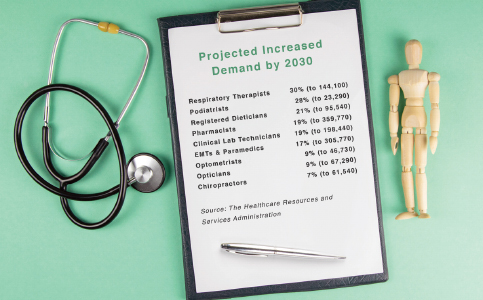In health professionals shortage, 96% of facilities using temps

For more than a decade, growing shortages of doctors and nurses have emerged as major concerns in communities across the country. The Association of American Medical Colleges projects a shortage of as many as 124,000 physicians by 2034, while the American Hospital Association estimates a need for at least 200,000 new registered nurses annually to keep abreast of escalating healthcare needs and replace retiring nurses.
Now a survey from AMN Healthcare – an agency that helps healthcare providers optimize their workforces to reduce complexity, increase efficiency and improve patient outcomes – found that 96% of hospitals and other healthcare facilities are turning to temporary allied professionals to fill gaps in their staffing.
According to the US Census Bureau, 22 million people are currently employed in healthcare and social services, making this the nation’s largest employment sector. About 60% are allied healthcare professionals, a designation that covers more than 80 job categories, from physical therapists and laboratory technicians to optometrists, pharmacists and paramedics.
AMN Healthcare’s 2021 Survey of Temporary Allied Staffing, released last month, “signals an emerging shortage of these workers,” said Robin Johnson, divisional president with AMN Healthcare. “The same pattern of labor shortages prevalent in nursing and medicine now are affecting the allied healthcare professions.”
Maureen Santangelo, president of Albion Staffing Solutions, which has offices across South Florida, says she has witnessed a sharp rise in requests for allied healthcare workers over the past year.
“We have had many physician practices and large groups reaching out for people in the last 12 months,” she said, “much more than normal.”
The majority of requests, Ms. Santangelo said, have been for Spanish-speaking medical assistants.
Nationwide, respiratory therapists are most in demand, the AMN Healthcare survey found, partially because of their role in the treatment of chronic obstructive pulmonary disease (COPD), the third leading cause of death in the US, after heart disease and cancer. But that demand has skyrocketed with Covid-19, which frequently causes long-term respiratory problems, and it’s expected to continue to rise as Omicron peaks.
Laboratory technologists and radiologic technologists ranked second and third.
“This is a national crisis,” said Michelle Kligman, senior vice president of human resources administration for Jackson Health System, which includes Jackson Memorial Hospital at 1611 NW 12th Ave. – the major teaching facility for the University of Miami Leonard M. Miller School of Medicine and the axis of a system of satellite facilities around South Florida.
Ms. Kligman said that in addition to recurring cycles of Covid-19, the recent opening of Jackson West Medical Center, a campus situated to serve the growing communities of Doral, Westchester, Sweetwater, Hialeah and Miami Lakes, has exacerbated the need for permanent and temporary allied healthcare personnel. Respiratory therapists and medical technologists are at the top of that list.
Every time there is a peak in covid cases, she said, staffing agency rates also spike.
“Because of the cost, this is not a sustainable long-term strategy,” Ms. Kligman said. “We are trying to tackle it on different fronts, looking at short-, medium- and long-term solutions.
“We have increased our sign-on bonuses and expanded from local recruitment to regional and even international recruitment.”
For the long term, she said, Jackson is partnering with schools – colleges, universities, even high schools – to create a pipeline of graduates prepared to step in.
We ask them, ‘Do you have a program? If not, how can we help you offer one?’” Ms. Kligman said. “Because academic programs are a win for everyone.”
The AMN Healthcare survey found that “a primary reason cited for the use of temporary allied professionals is to prevent burnout of existing staff, a finding that underscores the prevalence of burnout among healthcare professionals caused by the Covid-19 pandemic.”
“Our nurses are exhausted,” Ms. Kligman said. “It’s been two years now since they’ve had any time off. Our hats go off to them. We look for ways we can alleviate some of the stress on the floor, For example, nurses usually draw blood, but if we can have a phlebotomist do it we can take that off their plate.”
The US Bureau of Labor Statistics reports that 589,000 healthcare workers quit their jobs in September 2021 alone, representing an unprecedented 35% voluntary attrition rate.
“People are re-evaluating their life choices,” Ms. Kligman said. “Some are taking a break from healthcare, and others have quit altogether.”
Labor shortages among allied healthcare professionals could have far-reaching consequences.
“The high demand for radiologic technologists, who operate X-ray, MRI and other imaging equipment, suggests that patient utilization of medical procedures and other services is rising after being temporarily depressed by the pandemic,” said Mr. Johnson of AMN Healthcare. “Without the presence of laboratory technologists, imaging technologists, and other allied professionals, the tests and data required to conduct medical procedures and treatments backlogs, and the entire process can slow to a halt.”







Recent Comments